Triumph is one of the oldest motorcycle manufacturers in the world and is the largest British motorcycle brand. Like most notable motorcycle brands, Triumph also went through several ownership changes and wartimes which caused a financial crisis and a drop in production. However, after the revival of Triumph in 1983, the company flourished and became the largest surviving British motorcycle brand. Triumph motorcycles are well-recognized all over the world for their modern classic looks and impressive performance. Over the years, it has successfully built the image of a top versatile motorcycle manufacturer while producing sports bikes, roadsters, naked bikes, cruisers, and adventure bikes. Read this article to learn about the remarkable history of Triumph.
Table of Content
1. Triumph Motorcycles
| Triumph Motorcycles | |
|---|---|
|
|
|
| Name | Triumph Motorcycles Ltd. |
| Industry | Motorcycle Manufacturing |
| Founded In (Year) | 1983 |
| Founded In (Place) | Hinckley, Leicestershire, England |
| CEO | Nick Bloor |
| Predecessor Company | Triumph Engineering |
| Founded In (Year) | 1885 |
| Founded In (Place) | Meriden, England |
2. The Remarkable History of Triumph
1883
Siegfried Bettmann, the founder of Triumph Cycle Company, migrated from Nuremberg, Germany to reside in Coventry, England in 1883.
1884
2.1 Establishment of Bettmann & Co.
In 1884, Bettmann decided to import bicycles and sewing machines from Germany and sell them in the U.K. He formed a company in London, known as S.Bettmann & Co. Import & Export. The bicycles and sewing machines were sold in the U.K. under the new company’s name.
1886
In 1886, the company was renamed Triumph Cycle Company.
1887
In 1887, Dunlop Pneumatic Tyre became an investor in the company, and the brand name was changed to New Triumph Co. Ltd. Moritz Schulte, who also belonged from Nuremberg, Germany, joined the company as a partner. Schulte had the experience of working as a bicycle engineer and had previously worked at Wm Andrews Bicycles.
1888
In 1888, both Bettmann and Schulte discussed the operations of the company. Schulte proposed that Triumph should also start manufacturing its products. In the same year, a manufacturing plant was established in Coventry and the investment was made by both Bettmann and Schulte.
1889
In 1889, New Triumph Co. produced its first-ever bicycle.
1896
Due to their German roots, Bettmann and Schulte established a bicycle manufacturing plant in Nuremberg, Germany as well.
1898
In 1989, Bettmann and Schulte decided to expand their operations and manufacture motorcycles.
1902
2.2 The First Motorized Bicycle
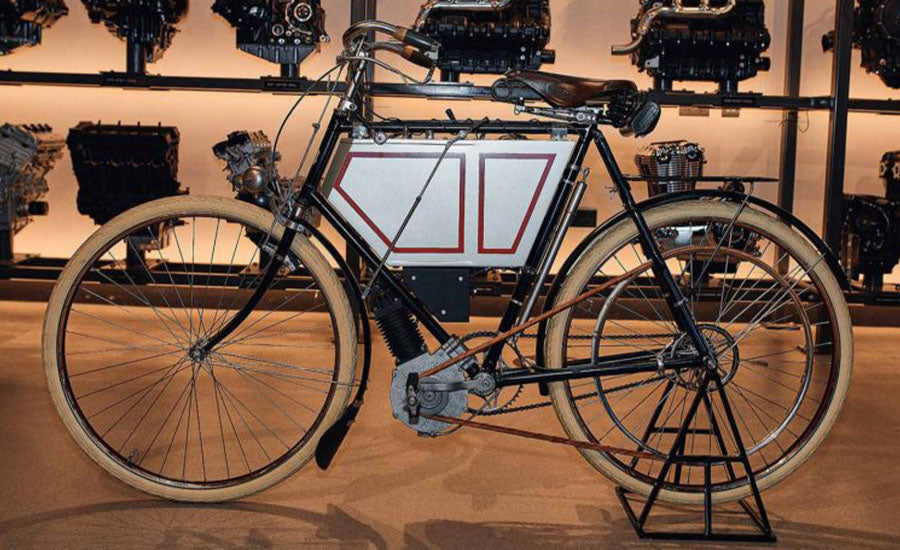
In 1902, New Triumph Co. produced its first-ever motorized bicycle, powered by a Belgian 2.2 hp Minerva engine capable of producing a horsepower of 3 hp.
1903
The company became self-sufficient in producing and selling motorcycles in bulk. More than 500 units were sold when it decided to establish a motorcycle manufacturing plant in Nuremberg, Germany.
1904
In 1904, New Triumph Co. decided to design its unique motorcycles as initially, Triumph motorcycles were inspired by designs of other manufacturers.
1905
In 1905, New Triumph Co. was successful in producing a motorcycle, entirely designed at the in-house manufacturing facility. The company was able to complete more than 250 units at the end of 1905.
1907
2.3 Establishing a New Manufacturing Plant
In 1907, New Triumph Co. established another large manufacturing plant to increase its manufacturing capacity. Triumph also launched a cheaper brand, called Gloria, and started production at the same manufacturing facility.
At that time, Triumph motorcycles were produced in both the U.K. and Germany. To clear the confusion, Triumph motorcycles produced in Nuremberg, Germany were renamed Orial. However, there already existed a company with the name Orial in France. Finally, the brand name was changed again to become Triumph Werke Nürnberg (TWN).
1908
In 1908, Triumph secured its first win at the Isle of Man TT. Jack Marshall was able to maintain a top average speed of 40 mph in this race while riding a 3 hp Triumph motorcycle.
1910s
2.4 World War I Era
During World War I, production was majorly shifted to assist the military and allies. More than 30,000 motorcycles were built and delivered for this purpose. The most notable Triumph model produced during wartime was the Triumph Model H, a roadster-style motorcycle, also marketed as the Trusty Triumph. It was considered to be the first modern motorcycle due to being fitted with a 499 cc single-cylinder engine capable of delivering a horsepower of 4 hp. The Triumph Model H could attain a top speed of 50 mph and could be used for hundreds of miles a day without a breakdown.
Triumph Model H A.K.A Trusty Triumph
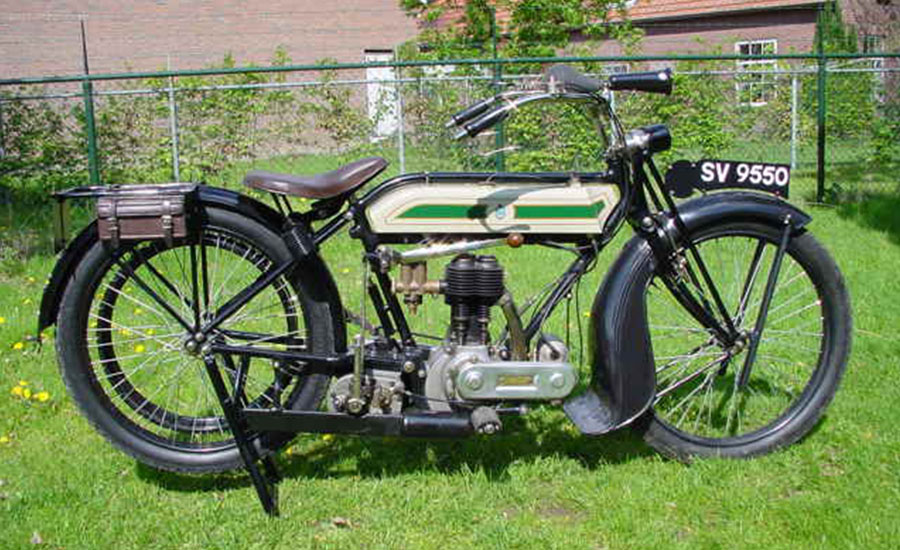
1920s
2.5 Disassociation Between Bettmann and Schulte
After World War I, a disagreement took place between Bettmann and Schulte regarding production. Schulte proposed that Triumph should start manufacturing cars rather than motorcycles while Bettmann disagreed, causing the association between the two to come to an end. It was an unfortunate event as Schulte left Triumph over this disagreement. However, the company purchased the Hillman Company in Coventry, which formerly used to manufacture cars, and produced its first car in 1923.
1923
In 1923, Triumph Motor Company manufactured its first saloon car.
Another key person in the history of Triumph, Harry Ricardo, who was an English engineer and pioneer in the field of combustion engines, developed a newly designed engine for Triumph’s latest model.
1925
In 1925, due to continuous improvements in design and engineering, Triumph became the largest British motorcycle and car manufacturer with the capability of producing more than 30,00 cars and motorcycles annually.
Along with cars and motorcycles, there was a huge demand for Triumph bicycles in the overseas markets. The overseas sales grew at a rapid pace, making it one of the company’s major sources of income.
1928
In 1928, Triumph produced the Triumph Super 7 and shortly after that produced the Triumph Super 8 which was considered to be a huge success as a car manufacturer.
1929
2.6 Great Depression Era
Triumph suffered a lot as the Great Depression started in 1929. It was an evident downfall as the company had to sell its German subsidiary to operate as a separate entity. The German subsidiary in Nuremberg was merged with another company, Alder, to continue its motorcycle production. The Triumph Werke Nürnberg (TWN) continued production until 1957.
1930s
As a result of the Great Depression, Triumph collapsed further and the economic condition led the company to sell its bicycle manufacturing plant to a major British bicycle production company, Raleigh Bicycle Co.
1933
In 1933, Bettmann was forced to quit his job as the chairman due to poor economic performance which made him completely disassociate himself from the company.
1936
Struggling to make any progress in car sales, Triumph decided to divide both the car and motorcycle manufacturing sectors into separate companies. In the same year, Triumph motorcycle company was purchased by Jack Sangster, the owner of the Ariel motorcycle company.
2.7 Expanding to the U.S. Market
In 1936, Triumph started exporting motorcycles to the U.S., making it one of the biggest markets for Triumph motorcycles.
1937
2.8 Establishing Triumph Engineering Co.
In 1937, Sangster established the Triumph Engineering Co. managed by the employees who worked at Ariel company.
Triumph Speed Twin
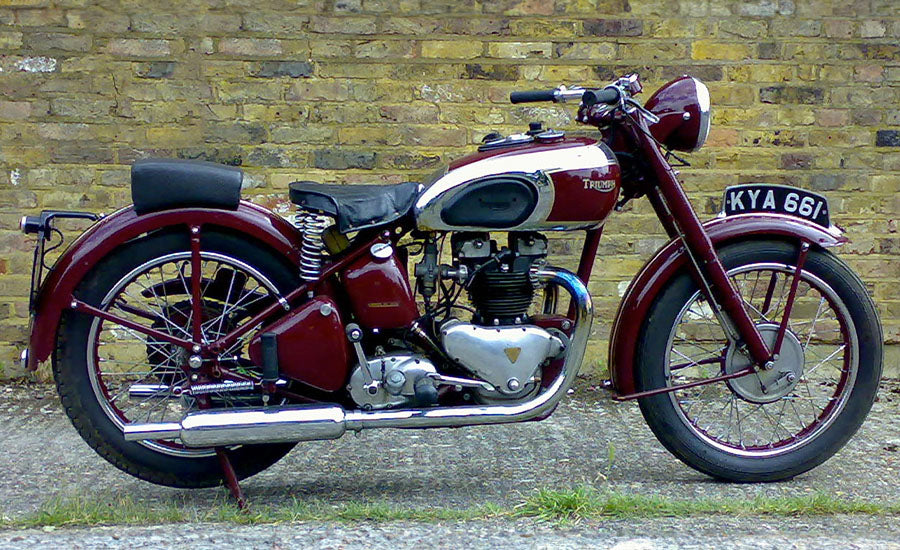
In September 1937, Edward Turner, who was working for Triumph Engineering Co. designed a new Triumph motorcycle, known as the Triumph Speed Twin.
1939
As the Triumph car manufacturing facility was struggling to make any profit, it went bankrupt in 1939 and was purchased by Standard Motor Company.
Triumph Tiger T100
In 1939, Edward Turner designed another Triumph motorcycle, called the Triumph Tiger T100, powered by a 500 cc engine. This motorcycle could attain a top speed of 100 mph.
1940s
2.9 World War II Era
The Triumph manufacturing facility was destroyed due to bombing in World War II, known as the Coventry Blitz. The city of Coventry was heavily destroyed. The production of Triumph motorcycles completely came to a standstill after the destruction.
1942
In 1942, Triumph Engineering established a new manufacturing plant in Meriden, Warwickshire after recovering the machinery and instruments at the Coventry facility.
2.10 Post-World War II
After World War II ended, the company decided to sell most of its production units in the U.S. to pay off its debts. The Triumph Tiger 100 and the Triumph Speed Twin designed by Turner were the two Triumph models that were produced in bulk.
1948
In 1948, the Triumph Engineering Co. introduced the Triumph TR5 Trophy Twin powered by a 498 cc engine at the 1948 Motorcycle Show. This motorcycle helped Triumph win the 1948 International Six Days Trial.
1949
Edward Turner continued designing new motorcycles for Triumph. In 1950, an upgraded version of the Triumph Speed Twin, known as the Triumph Thunderbird, was designed by Turner with a 650 cc engine.
1950s
The Triumph Thunderbird 6T received considerable recognition in the U.S. after being used in a movie, The Wild One.
1951
As Sangster was expected to become the chairman of Birmingham Small Arms Company (BSA) in 1956, he sold Triumph Engineering Co. to BSA in 1951.
1955
A new speed record of 193 mph was made on a customized 650 cc Triumph Thunderbird at The Devil’s Arrow in Bonneville Salt Flats, Utah, United States.
1956
In 1956, the iconic Triumph motorcycle, the TR6 Trophy powered by a 650 cc engine was introduced. This motorcycle was one of the best off-road motorbikes of its time. Both Dave Ekins and Bud Ekins secured several wins and made records in the U.S. desert races while riding on the Triumph TR6 Trophy.
1959
Triumph Tiger T120

In 1959, Triumph introduced the Triumph Tiger T120, the upgraded version of the Tiger T110, fitted with a twin carburetor for better performance. This model later became familiar with the name Bonneville. Triumph gained much popularity in the American market because of Bonneville and became a strong competitor of Harley Davidson.
Also Read: THE REMARKABLE HISTORY OF INDIAN MOTORCYCLE
1960s
2.11 Triumph Tigress and Triumph Tina Scooters
During the 1960s, despite strong opposition, Triumph developed two scooters: the Triumph Tigress and the Triumph Tina. The Triumph Tigress was made available in two trims, including a 175 cc two-stroke single-cylinder engine and a 250 cc four-stroke twin-cylinder engine.
1963
In 1963, the Triumph 650 TR6 Trophy Competition was featured in another movie, The Great Escape. This motorbike was used by Steve McQueen and Bud Ekins in the movie.
1966
Another speed record of 245 mph was made on a motorcycle, known as the Gyronaut X-1, designed by combining two Triumph 650 cc engines by Buddy Elmore at the Daytona 200.
1967
In 1967, sales of Triumph motorcycles increased exponentially. However, the company was unable to meet the increased demand.
2.12 Racing Success
In 1967, Triumph continued to excel after Gary Nixon won the Daytona 200 while riding on the Triumph Tiger 100. John Hartle also won the Isle of Man Production TT.
1969
2.13 Bonneville Winning Isle of Man TT
In 1969, Triumph won the Isle of Man TT Production Title thanks to Malcolm Uphill. He was able to maintain an average top speed of 99.99 mph. Uphill, on his Triumph Bonneville, attained the first-ever top speed of above 100 mph in a lap on a production motorcycle.
Triumph was successful in capturing almost half of the U.S. motorcycle market due to which the majority of its production was exported. Despite the huge market share, Triumph motorcycles lacked technological advancements and modern features.
1970s
2.14 Downfall of Triumph/BSA
Triumph started facing tough times due to the lack of technological advancements and the introduction of Japanese manufacturers in the U.S. market. Honda was all set to capture the global market with its top-class racing motorcycles equipped with modern features. Triumph was losing track in the U.S. and it became hard for it to exist in the U.S. after the government imposed several strict import laws for motorcycles.
Later, Honda also captured the large-displacement motorcycle market by introducing the Honda CB750. The newly-introduced Triumph Trident and BSA Rocket 3 were able to outperform Japanese motorcycles in several performance aspects, including handling, acceleration, and top speed. However, the Japanese motorcycles were highly reliable and required less maintenance.
Also Read: THE REMARKABLE HISTORY OF YAMAHA
1970
2.15 Winning the Production TT Another Time
In 1970, Peter Uphill secured another Isle of Man Production TT win for Triumph while riding a modified Triumph motorcycle, powered by a 750 cc three-cylinder engine.
1971
In 1971, BSA suffered a huge loss of £8.5 million and Triumph was sold to a new company, Manganese Bronze Holdings.
1972
2.16 Establishment of Norton Villiers Triumph (NVT)
In 1972, BSA went bankrupt after suffering from consecutive losses year after year. The government had to intervene, along with providing aid to the company. As a result of the government intervention, Dennis Poore had to take charge of BSA/Triumph. Poore had good experience in this field as he was already working as the chairman of Norton-Villiers Company, a subsidiary of Manganese Bronze Holdings. A new company was formed as a result of the merger of BSA/Triumph and Norton, known as the Norton Villiers Triumph (NVT).
1977
The NVT also could not survive and collapsed in 1977. As a result, other members of the company bought the rights to use Triumph as the brand name. A new firm was established with government aid, known as Triumph Motorcycles Meriden Ltd. The company kept producing and marketing two iconic Triumph models, including the Triumph Tiger and the Triumph Bonneville.
1978
In 1978, the 1977 Triumph Bonneville T140J, the Silver Jubilee Edition became one of the top-selling motorcycles in the U.S. and several European markets.
1979
Triumph Motorcycles introduced new models in 1979, including the Triumph Bonneville T140D Special and the Triumph Bonneville T140E in the U.S. market. However, this time, these motorcycles failed to make a good impact in the market. One of the major reasons for the sales decline in the U.S. market was the strong pound rate, resulting in high manufacturing costs and expensive Triumph motorcycles rate in the U.S. market.
1983
2.17 Bankruptcy
Several Triumph models were introduced, including the Triumph TR65 Thunderbird, TR7T Tiger Trail, Royal Wedding T140LE Bonneville, T140 TSX, and T140W TSS model. However, the debt-ridden company was not able to survive any longer. Triumph Motorcycles (Meriden) Ltd. went bankrupt on August 23, 1983.
2.18 Establishing Triumph Motorcycles (Hinckley) Ltd.
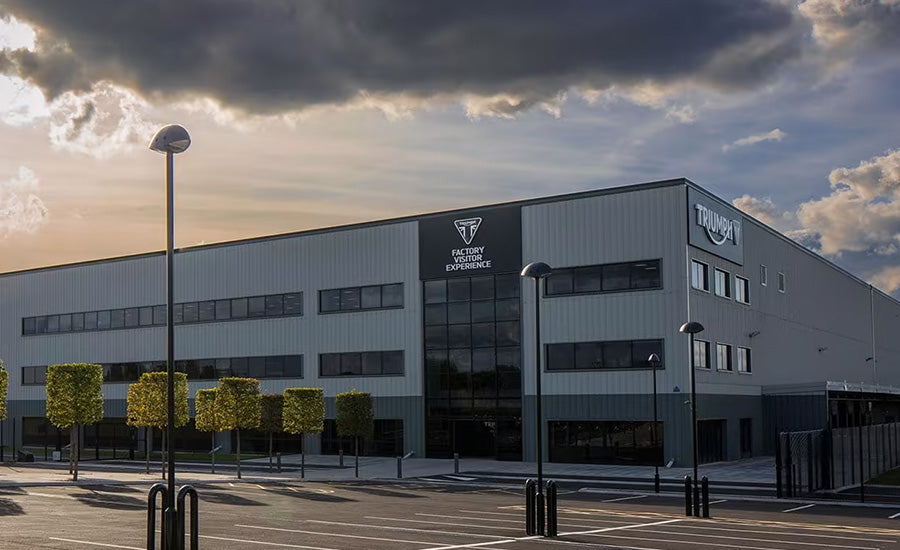
1983 marked the year of Triumph’’s revival when John Bloor came to rescue the brand name by purchasing Triumph’s manufacturing rights. The old manufacturing processes and marketing strategies were outdated and were not yielding good results. Therefore, several revolutionary decisions were made to change the outdated manufacturing facilities and processes, equipping them with technologically advanced plants to compete with the Japanese competitors.
The new company established was initially named Bonneville Coventry Ltd. To continue the original Triumph legacy, John Bloor decided to continue producing Triumph Bonneville models. While purchasing the rights, Bloor wanted to market Triumph as one of the longest-continuously producing motorcycle companies since 1902.
Bloor hired a few old experienced employees, including engineers and designers to start working on new designs. The manufacturing unit at Triumph also went on a tour to Japan to observe and study the manufacturing processes and techniques, particularly the inclusion of computer-operated machinery.
Also Read: THE REMARKABLE HISTORY OF KAWASAKI
1985
In 1985, Triumph purchased advanced machinery for its manufacturing facility to work on new designs.
1987
After continuous efforts by John Bloor, Triumph was successful in manufacturing its first engine, a 1,200 cc four-cylinder engine, at the Hinckley factory.
1988
Bloor continued working to expand the manufacturing capabilities of Triumph motorcycles and established a new manufacturing facility at Hinckley, Leicestershire.
1990s
Bloor was making headways by increasing the company’s manufacturing capabilities and distribution network. Triumph Motorcycles Ltd. also established several subsidiaries in different countries, including Triumph France SA. and Triumph Deutschland GmbH.
1990
In 1990, Triumph Motorcycles introduced several new models, including the sporty-style 750 cc and 1,000 cc Triumph Daytona, the 905 cc and 1,200 cc touring bike Triumph Trophy, and a 750 cc and 900 cc Triumph Trident without fairings.
1994
In 1994, the export to America started once again when Bloor established a new subsidiary, named Triumph Motorcycles America Ltd. Two new adventure bikes were introduced, including the Triumph Speed Triple and the Triumph Tiger 900.
1996
In 1996, the 50,000th motorcycle was produced at the Hinckley factory which was named the Triumph Daytona T595.
2000
Bloor had invested around £100 million since 1983 in purchasing the rights, company, and a new manufacturing facility and it reached the break-even point in 2000. The company also relaunched the Triumph Bonneville lineup with classic styling to attract riders of all ages.
2002
2.19 Fire Incident at the Main Factory
March 2002
An unfortunate event occurred on March 15, 2002, when Triumph’s manufacturing plant caught fire, and almost half of the factory, including the production and assembly lines were destroyed. The incident took place while the company was planning to celebrate its 100th Anniversary.
May 2002
Triumph established another manufacturing and assembling plant in Chonburi, Thailand in May 2002 to manufacture Triumph motorcycle parts.
September 2002
In the same year, Triumph managed to rebuild the factory to continue manufacturing motorcycles.
2003
After 27 years, Bruce Anstey managed to secure its first Isle of Man TT win for Triumph Motorcycles in 2003 while riding the Triumph Daytona, powered by a 600 cc engine.
2004
2.20 Motorcycle with the Largest Engine-Displacement
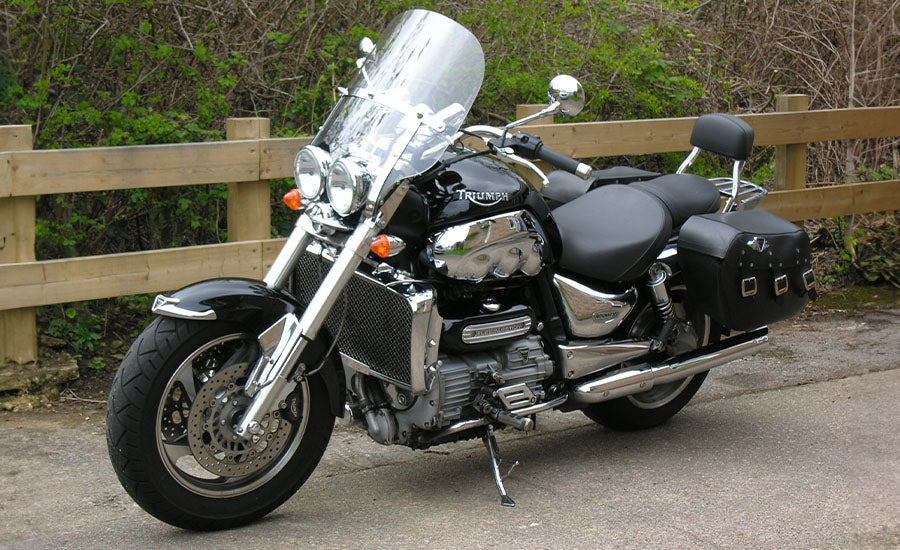
Started in 1998, the Triumph Rocket III was introduced in 2004, powered by the largest 2,294 cc engine ever installed on a motorcycle. The inline three-cylinder engine was capable of producing a horsepower of 148 hp. Being a cruiser-style motorcycle, the engine was designed to produce an impressive torque of 196.1 Nm.
2006
To strengthen the partnership with Thailand, another manufacturing and assembling plant was established in 2006 by Prince Andrew, a member of the Royal Family. An award-winning motorcycle, the Triumph Daytona, powered by a 675 cc engine was also introduced in 2006.
2007
After the success of Triumph in Thailand, the company decided to further expand its size in the country, and a third manufacturing plant was established in 2007 to manufacture motorcycle parts. In the same year, Triumph announced an increase in its manufacturing capacity by also increasing the number of employees.
Triumph Street Triple
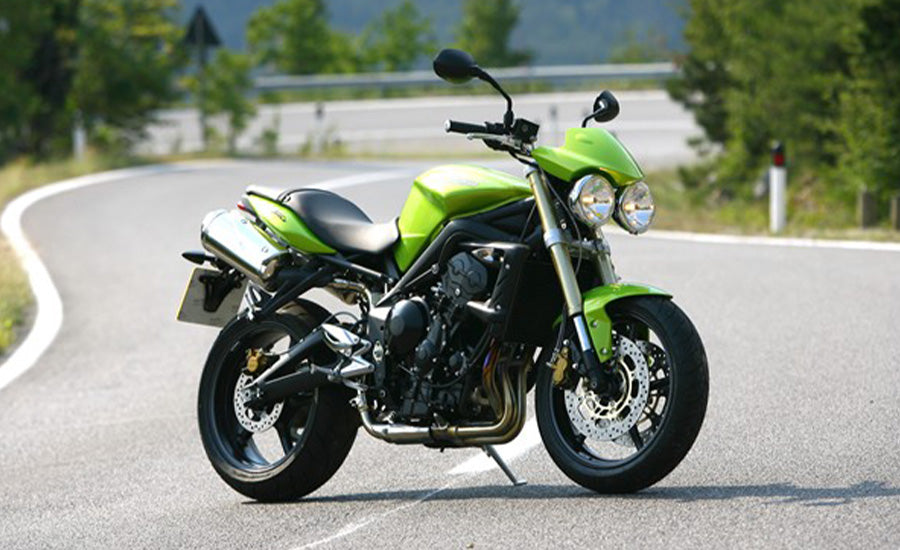
In 2007, Triumph Motorcycles introduced an upgraded Triumph Daytona 675, known as the Triumph Street Triple with improved handling and performance.
2008
In 2008, Glen Richards won the first British Superbike Championship Title for Triumph Motorcycles after the company’s revival in 1983.
2009
In 2009, a new Triumph model, the Triumph Thunderbird dual-cylinder cruiser, powered by a 1,600 cc engine was introduced by the former Minister of State, Digby Jones.
In the same year, another modern Triumph was introduced, known as the Triumph Street Triple R with advanced suspension and braking system for superior performance.
2011
2.21 Nick Bloor - The New CEO
In 2011, Nick Bloor, who was the son of John Bloor, took charge of Triumph Motorcycles as the new CEO.
2012
In 2012, Triumph established new manufacturing facilities in Brazil, and new models, including the Triumph Trophy and the Triumph Tiger Explorer, were introduced, along with upgrades in existing Triumph models.
2014
2.22 Winning IoM Supersport TT
Along with the financial success, Triumph achieved another milestone when Gary Johnson secured the first position at the 2014 Isle of Man Supersport TT while riding the modified Smiths Triumph Daytona 675R.
2.23 Winning British Supersport Championship
In the same year, Billy McConnell won the British Supersport Championship Title while riding the same modified version of the Daytona 675R.
2.24 Winning Daytona 200 After 47 Years
Danny Eslick won the Daytona 200 title after 47 years for Triumph while riding the Daytona 675R in 2014.
2015
In 2015, Triumph introduced several new motorcycles named after its classic models, including the Triumph Thruxton, Thruxton R, Bonneville T120, and the Street Twin.
2016
As Triumph continues to grow in size and operation, it launched a whole new series of modern-classic motorcycles, including the Triumph Bonneville T100, the Triumph Street Scrambler, the Triumph Street Cup, and the Triumph Bonneville Bobber.
2017
To showcase the history and memorabilia of Triumph Motorcycles, the company decided to open a visitor center at Hinckley and to allow visitors a factory tour.
2.25 Financial Performance
2017 proved to be a successful year for Triumph as the company’s revenue increased by 22%. The company made record sales in 2007 by selling more than 9,400 units in the U.K. with more than 85% of the total production being exported overseas.
2.26 Partnership with Bajaj
In 2017, Triumph partnered with an Indian-based motorcycle company, Bajaj, along with the Husqvarna and KTM to produce low-powered motorcycles with small-displacement engines for Asian and developing markets. Although the agreement said that the motorcycles would be marketed under the Triumph brand, Bajaj got an opportunity to collaborate, improve, promote, and have access to top-class manufacturing plants and operations.
2.27 The All-New 765 cc Triumph Street Triple

In 2017, Triumph developed one of its most successful and technologically advanced motorcycles, called the Triumph Street Triple powered by an all-new 756 cc engine. In the same year, the company collaborated with Dorna Sports to produce specialized race-inspired engines for the 2019 Moto2 World Championship.
2018
In 2018, two old Triumph motorcycles were brought back, including the Triumph Scrambler 1200 and the Triumph Speed Twin with modern features.
2019
In 2009, Triumph participated in the Moto2 World Championship as an engine provider. In this race, the motorcycle powered by the Triumph engine made a top speed record of 300 km/h. Triumph also helped Alex Marquex win the race.
2.28 Triumph Rocket 3 - A Production Motorcycle with the Largest Engine Displacement
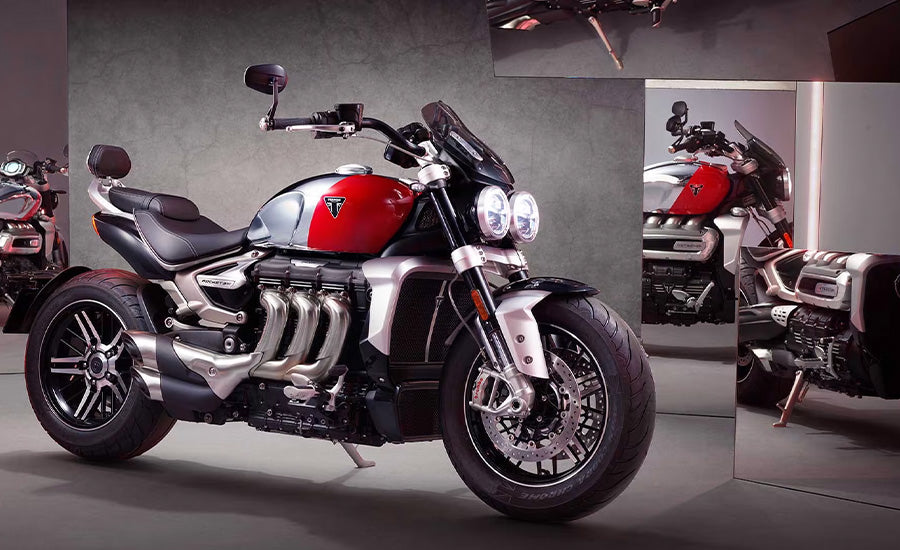
In 2019, Triumph introduced an upgraded and more powerful version of the previous Triumph Rocket III, called the Triumph Rocket 3. The engine size was further increased to 2,458 cc. The inline three-cylinder engine was capable of delivering a horsepower of 165 hp and a torque of 221 Nm. Despite being the most powerful production motorcycle, the Triumph Rocket 3 is electronically restricted to not go above 145 mph.
2020
2.29 Thailand Became the Production Hub
In 2020, Triumph decided to move most of its production to Thailand factories while only leaving the production of prototypes and factory customs motorcycles at the U.K. manufacturing facilities. Due to this transfer of production facilities on such a large scale, many employees working in the production department lost their jobs. The Research and Development (R&D) center continued to work in the U.K.
Triumph Trident 660
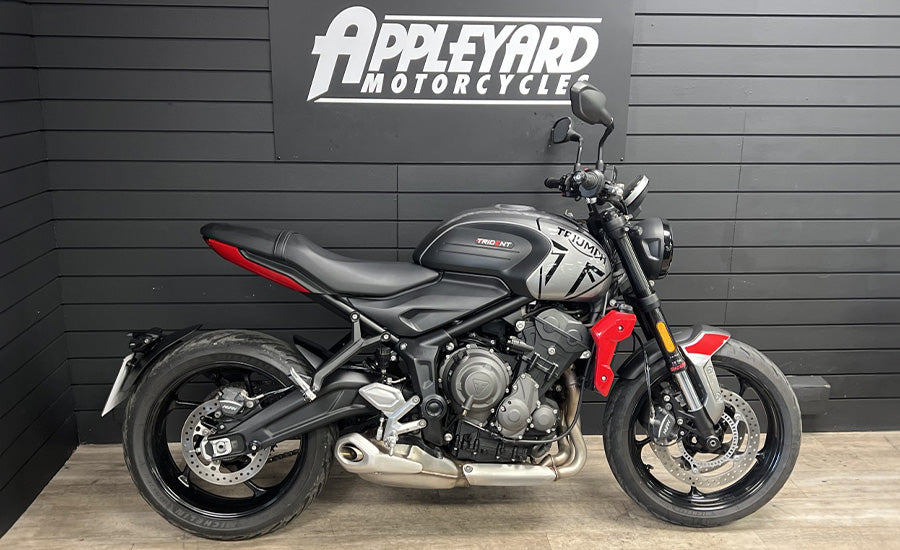
In 2020, Triumph launched another successful model, the Triumph Trident 660, designed for new riders. This motorcycle ensures superior handling and is fitted with several modern riding aids.
2021
In 2021, Triumph decided to become a versatile motorcycle brand and started working on producing enduros and motocross bikes. To promote new ideas and designs, the company collaborated with Iván Cervantes, a five-time enduro-racing championship winner, and Ricky Carmichael, a five-time supercross racing champion.
2023
2.30 Success in the Indian Market
In 2023, two new motorcycles were launched under the collaboration of Triumph/Bajaj, including the Scrambler 400 and the Speed 400, which are low-powered versions of the original Triumph Scrambler 1200 and the Triumph Speed Twin 1200. These low-powered Triumph/Bajaj models immediately became popular in India and the company had to speed up the production.
2.31 Milestones
- Triumph is one of the longest-running motorcycle manufacturers in the world and has produced more than 8 million motorcycles since its birth. Approximately 50% of its total production was completed after 1980.
- Though Triumph is a British motorcycle manufacturer, the company sells more than 85% of its production units overseas.
- Triumph has become a large-scale industry with more than 2,000 employees working worldwide.
- It received the “2020 Best Bike of the Year”, “Best Cruiser Bike of the Year”, and “Best Adventure Bike of the Year” awards recently.
- With a presence in 35 countries and more than 700 dealerships worldwide, Triumph is the largest British motorcycle manufacturer.
- Triumph sells more than 51,000 motorcycles each year.
- Triumph has the capacity and capability of producing more than 60,000 motorcycles per year.
2.32 Current 2023 Triumph Lineup
| 2023 Triumph Motorcycle Lineups | |||||
|---|---|---|---|---|---|
| Category | Motorcycle | Base Price | Engine | Horsepower | Torque |
| Adventure Bikes | Triumph Tiger Sport 660 | $9,695 | 660 cc | 81 hp | 47 lb-ft |
| Triumph Tiger 850 Sport | $12,290 | 888 cc | 84 hp | 60 lb-ft | |
| Triumph Tiger 900 GT Range | $14,995 | 900 cc | 94 hp | 64 lb-ft | |
| Triumph Tiger 900 Rally Range | $15,695 | 900 cc | 94 hp | 64 lb-ft | |
| Triumph Tiger 1200 GT | $19,595 | 1,160 cc | 147 hp | 95 lb-ft | |
| Triumph Tiger 1200 Rally | $22,995 | 1,160 cc | 147 hp | 95 lb-ft | |
| Modern Classics | Triumph Speed 400 | Will be Available in 2024 | 398 cc | N/A | 28 lb-ft |
| Triumph Scrambler 400 X | Will be Available in 2024 | 398 cc | N/A | 27.7 lb-ft | |
| Trumph Speed Twin 900 | $9,895 | 900 cc | 64 hp | 59 lb-ft | |
| Triumph Boneville T100 | $10,995 | 900 cc | 64.1 hp | 59 lb-ft | |
| Triumph Scrambler 900 | $11,495 | 900 cc | 64 hp | 59 lb-ft | |
| Triumph Bonneville T120 | $12,695 | 1,200 cc | N/A | 77.4 lb-ft | |
| Triumph Speed Twin 1200 | $12,895 | 1,200 cc | 100 hp | 83 lb-ft | |
| Triumph Scrambler 1200 | $14,745 | 1,200 cc | 89 hp | 81.1 lb-ft | |
| Triumph Bonneville Bobber | $13,795 | 1,200 cc | 76 hp | 78 lb-ft | |
| Triumph Bonneville Speedmaster | $13,795 | 1,200 cc | 76 hp | 78 lb-ft | |
| Triumph Thruxton RS | $16,995 | 1,200 cc | 103 hp | 83 lb-ft | |
| Roadster | Triumph Trident 660 | $8,595 | 660 cc | 81 hp | 47 lb-ft |
| Triumph Street Triple 765 | $9,995 | 765 cc | 120 hp | 59 lb-ft | |
| Triumph Street Triple 765 Moto2TM Edition | $15,395 | 765 cc | 128 hp | 59 lb-ft | |
| Triumph Speed Triple 1200 RS | $18,895 | 1,160 cc | 177 hp | 92 lb-ft | |
| Triumph Speed Triple 1200 RR | $20,950 | 1,160 cc | 177 hp | 92 lb-ft | |
| Triumph Street Triple | $10,945 | 765 cc | N/A | 58 lb-ft | |
| Rocket 3 | Triumph Rocket 3 | $23,895 | 2,500 cc | 165 hp | 163 lb-ft |
| Chrome Collection | Triumph Speed Twin 900 Chrome Edition | $10,395 | 900 cc | 64 hp | 59 lb-ft |
| Triumph Bonneville T100 Chrome Edition | $11,495 | 900 cc | 64.1 hp | 59 lb-ft | |
| Triumph Scrambler 900 Chrome Edition | $11,995 | 900 cc | 64 hp | 59 lb-ft | |
| Triumph Bonneville T120 Chrome Edition | $13,495 | 1,200 cc | N/A | 77.4 lb-ft | |
| Triumph Bonneville Bobber Chrome Edition | $14,595 | 1,200 cc | 76 hp | 78 lb-ft | |
| Triumph Bonneville Speedmaster Chrome Edition | $14,595 | 1,200 cc | 76 hp | 78 lb-ft | |
| Triumph Scrambler 1200 XE Chrome Edition | $16,995 | 1,200 cc | 89 hp | 81.1 lb-ft | |
| Triumph Thruxton RS Chrome Edition | $17,795 | 1,200 cc | 103 hp | 83 lb-ft | |
| Triumph Rocket 3 R Chrome Edition | $24,795 | 2,500 cc | 165 hp | 163 lb-ft | |
| Triumph Rocket 3 GT Chrome Edition | $25,495 | 2,500 cc | 165 hp | 163 lb-ft | |
| Special Editions | Triumph Tiger 900 GT Aragon Edition | $16,495 | 900 cc | 94 hp | 64 lb-ft |
| Triumph Tiger 900 Rally Aragon Edition | $16,995 | 900 cc | 94 hp | 64 lb-ft | |
| Triumph T120 Black DGR Limited Edition | $13,495 | 1,200 cc | N/A | 77.4 lb-ft | |
| Triumph Rocket 3 R 221 | $24,795 | 2,500 cc | 165 hp | 163 lb-ft | |
| Triumph Rocket 3 GT 221 | $25,495 | 2,500 cc | 165 hp | 163 lb-ft | |
3. Wrap-Up
Triumph is one of the oldest motorcycle manufacturers, yet the producer of the class-leading modern classic motorcycles that are popular worldwide. The company underwent several ownership changes after being launched in 1885. It was revived by John Bloor in 1983. Under John Bloor's leadership, Triumph grew in size and expanded its manufacturing capability by improving its production and marketing processes. As of today, Triumph produces one of the most technologically advanced and high-performance modern-classic motorbikes. If you are looking for a perfectly finished and aesthetically appealing classic motorcycle with modern features, Triumph offers the most impressive motorcycle lineups.
Triumph Motorcycles’ primary goal is to acquire a significant share of the American market as sales are constantly growing in the region. Several Triumph motorcycles that are engineered for long-distance riding can be customized for improved touring capabilities. Hence, with the installation of saddlebags available at Viking Bags, you can make your Triumph motorcycle ideal for touring. Viking Bags offers specially designed high-quality saddlebags for your Triumph Bonneville T100, Bonneville T120, Triumph America, Rocket III Roadster, Speedmaster, Thunderbird, and Scrambler.

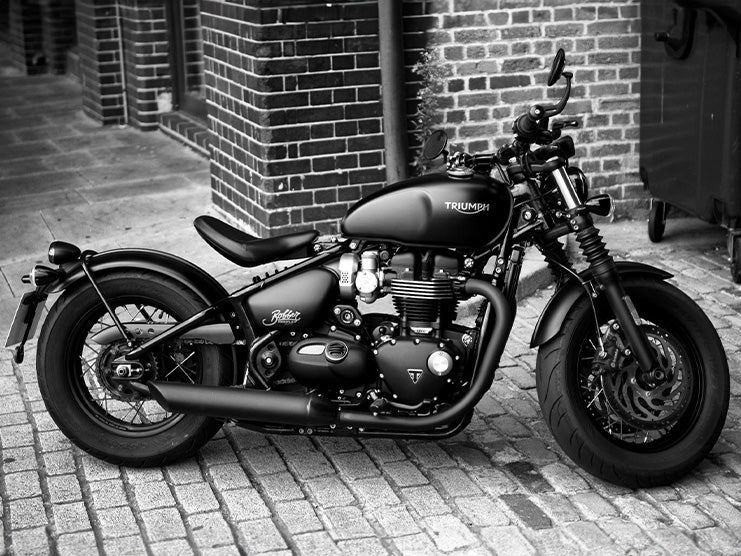
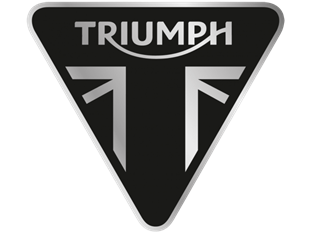









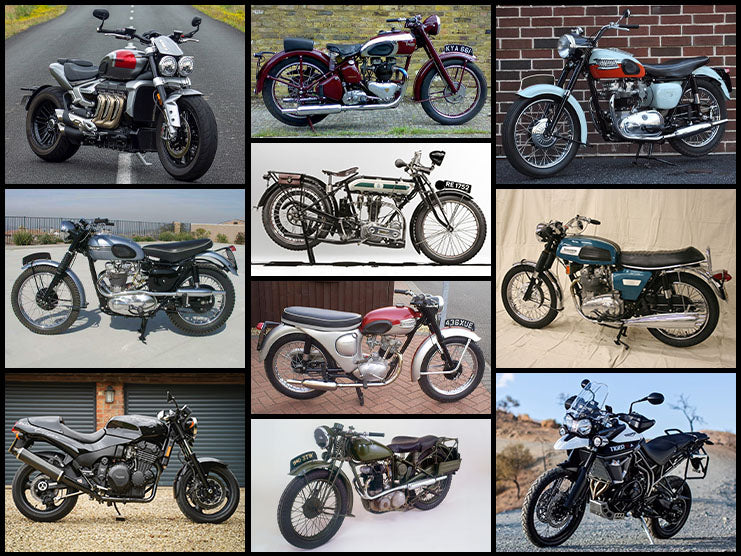
Leave a comment
All comments are moderated before being published.
This site is protected by hCaptcha and the hCaptcha Privacy Policy and Terms of Service apply.